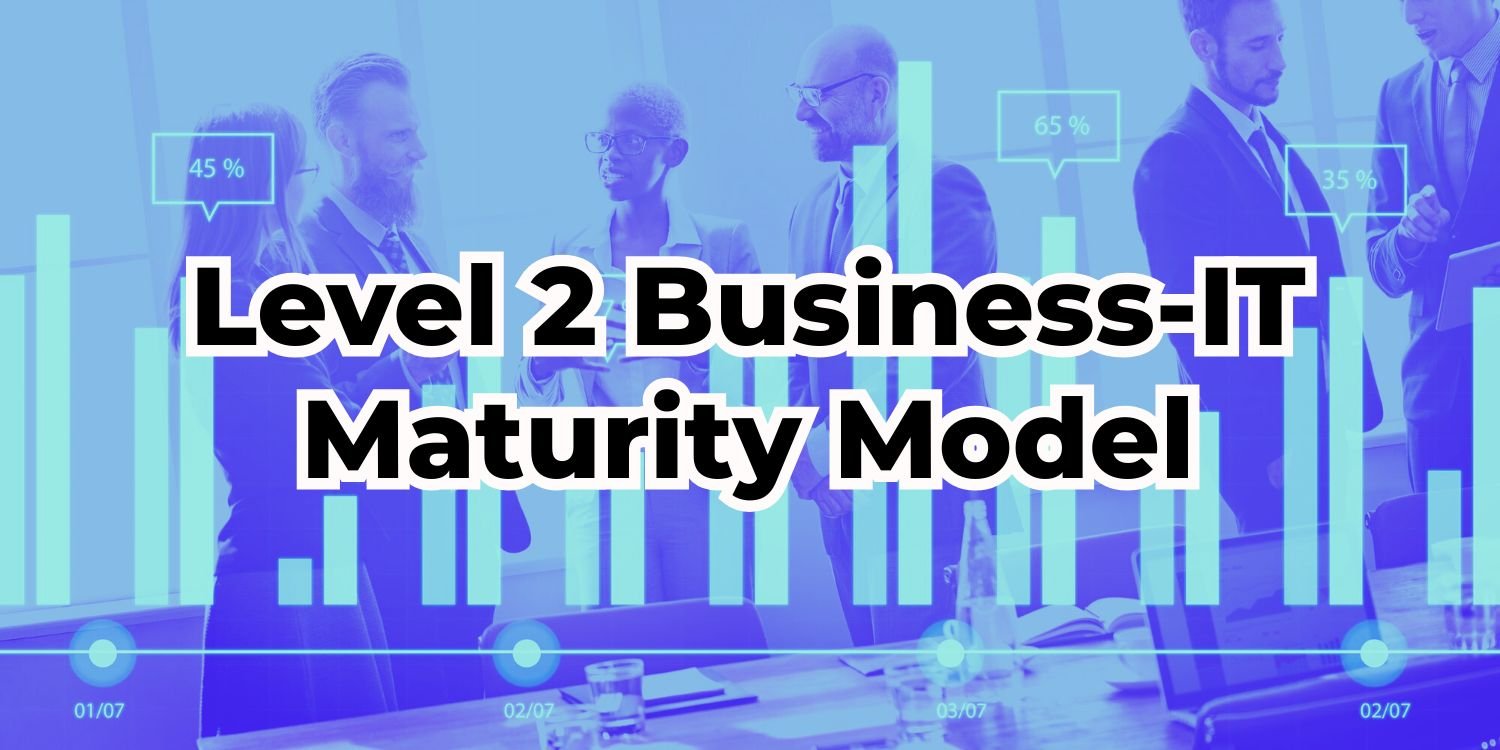
Level 2 Business-IT Maturity Model: Understanding and Advancing Your IT Strategy
Level 2 Business-IT Maturity Model: Understanding and Advancing Your IT Strategy
The Business-IT Maturity Model serves as a guiding framework for organizations to evaluate the maturity of their business and IT processes and improve the alignment between IT capabilities and business objectives. A mature IT environment is critical for organizations to support business growth, optimize resources, and maintain competitive advantage. In this article, we will delve into Level 2 of the Business-IT Maturity Model, its characteristics, and practical strategies to enhance process maturity.
What is a Business-IT Maturity Model?
A Business-IT Maturity Model is a structured approach to assess the maturity of an organization’s IT processes, governance, and overall alignment with business goals. It helps organizations identify gaps, define roadmaps, and implement strategies for improving IT effectiveness. The model is often divided into five levels, each representing an increasing degree of maturity and strategic integration:
The 5 Levels of Business-IT Maturity:
- Level 1 – Initial: Processes are ad hoc, with minimal or no standardization.
- Level 2 – Managed: Basic processes are in place, but execution is often inconsistent.
- Level 3 – Defined: Processes are standardized and documented.
- Level 4 – Quantitatively Managed: Performance is measured, and processes are optimized based on data.
- Level 5 – Optimized: Continuous improvement is embedded in the organization’s culture.
The Importance of the Business-IT Maturity Model:
Organizations use maturity models to optimize IT investments, improve decision-making, and ensure that technology strategies are aligned with business priorities. A higher level of IT maturity reflects an organization’s ability to respond rapidly to changes, improve operational efficiency, and deliver enhanced value to stakeholders.
What is Level 2 of the Business-IT Maturity Model?

Level 2, or the “Managed” stage, represents a fundamental step towards establishing repeatable and consistent IT processes. At this stage, some level of control exists over key IT activities, but the overall process integration is limited. Although organizations have defined roles and responsibilities, execution can still vary widely, making it difficult to predict outcomes with high reliability.
Characteristics of Level 2:
- Basic IT Governance: Establishment of basic IT policies and governance frameworks.
- Documented Processes: Core IT processes are documented and repeatable.
- Reactive Management: IT management is reactive rather than proactive, responding to incidents as they arise.
- Project-Oriented Approach: Processes are typically managed on a project-by-project basis.
- Limited Process Integration: There is minimal integration between IT and business processes, leading to silos.
Core Processes at Level 2:
- IT Service Management: Basic incident and problem management processes are in place.
- Resource Management: Limited control over IT resources, with basic allocation practices.
- Change Management: A formalized change management process is initiated but lacks cross-departmental involvement.
- Project Management: Project management methodologies are adopted but applied inconsistently.
Example: Level 2 Business-IT Maturity in Action
Consider a mid-sized manufacturing company where IT processes are established to support production scheduling, but they are not standardized across all departments. While the IT team documents workflows, deviations occur frequently, leading to reactive problem-solving rather than preventative strategies. This scenario reflects the inconsistencies typical of Level 2 maturity.
Comparison with Other Levels:
- Level 1 vs. Level 2: At Level 1, there is no predictability in outcomes due to the lack of process controls. At Level 2, processes are managed and repeatable, although not consistently executed.
- Level 2 vs. Level 3: Level 3 involves full standardization and documentation of processes across the organization, ensuring consistency and reliability.
Understanding IT Maturity and Assessment Models

Organizations use various maturity models, such as McKinsey and Gartner, to evaluate their IT maturity and strategize improvements. While these models may differ in approach, they all aim to provide a clear pathway for process optimization and business-IT alignment.
1. McKinsey’s Business Maturity Model:
McKinsey’s model focuses on business process optimization and strategic alignment. It emphasizes maturity in terms of business impact, competitive advantage, and operational efficiency.
2. Gartner’s IT Maturity Model:
Gartner’s model is designed to measure IT capabilities and assess the maturity of IT services, infrastructure, and governance. It helps organizations develop a detailed maturity scorecard to track progress over time.
3. IT Maturity Assessment Scorecard:
An IT maturity scorecard is a tool used to quantify the current state of IT maturity. It typically includes categories such as governance, project management, and service delivery, with scoring metrics to identify areas for improvement.
Step-by-Step Guide to Assessing IT Maturity:
- Identify Key IT Processes: Determine which processes are critical to your organization’s success.
- Assess Current Maturity: Use a scorecard or questionnaire to evaluate the maturity of each process.
- Analyze Gaps: Compare current maturity against desired maturity levels.
- Develop a Roadmap: Create an action plan to bridge the gaps and advance to higher maturity levels.
- Implement and Monitor: Execute the plan and continuously monitor progress.
Developing an Effective IT Maturity Strategy
To move from Level 2 to Level 3, organizations need to standardize their IT processes and ensure they are applied consistently across all departments. Here’s a structured approach to advancing your IT maturity:
1. Building a Roadmap:
- Define Standard Processes: Establish standard operating procedures (SOPs) for key IT activities.
- Train Staff: Ensure that all team members are trained to follow documented processes.
- Establish Performance Metrics: Set clear KPIs to measure the success of process standardization.
2. Tools and Templates for IT Maturity Assessment:
- Use templates such as IT maturity questionnaires, scorecards, and checklists to evaluate and document your maturity level.
- Implement project management tools like Asana or Microsoft Project to standardize workflows.
3. Best Practices for Enhancing IT Processes:
- Adopt ITIL Frameworks: Use ITIL practices for service management.
- Implement Governance Structures: Establish governance committees to oversee the implementation of standardized processes.
- Embrace Automation: Use automation tools to minimize manual errors and improve efficiency.
Business-IT Maturity Models in Action
Case Studies Demonstrating Successful Implementation:
- Case Study 1: A financial services company used the Gartner model to assess its IT capabilities and discovered a lack of standardized processes. By implementing Level 2 to Level 3 strategies, they achieved a 30% improvement in project delivery time.
- Case Study 2: A healthcare organization implemented the McKinsey maturity framework and standardized its IT processes, resulting in better resource management and a significant reduction in operational costs.
Challenges at Different Levels of Maturity:
- Level 2 Challenges: Inconsistencies in process execution, reactive problem-solving, and minimal cross-departmental integration.
- Strategies to Overcome Challenges: Implement cross-functional teams, focus on process training, and use monitoring tools to ensure compliance.
Resource Library for Advancing IT Maturity
Downloadable PDFs and Templates:
- IT Maturity Assessment Scorecard
- IT Maturity Questionnaire Template
- Roadmap Template for IT Maturity Advancement
By understanding and implementing the principles of the Business-IT Maturity Model, organizations can enhance their IT capabilities, achieve strategic alignment, and ultimately deliver greater business value. Whether you are at Level 2 or looking to move up the maturity ladder, structured assessments and targeted strategies are key to driving IT excellence.
Conclusion
The Level 2 Business-IT Maturity Model is a critical stage in the journey toward optimizing IT processes and aligning them with business objectives. At this level, organizations have basic but documented processes, enabling them to achieve more predictable results compared to Level 1. However, true strategic value comes from advancing to higher maturity levels, where processes are fully standardized, performance is data-driven, and continuous improvement is embedded in the organization’s culture. By understanding the characteristics and challenges of Level 2, businesses can implement targeted strategies to achieve greater efficiency, improve IT governance, and lay the groundwork for future growth and innovation.
FAQs
Q1: What is a Level 2 process maturity?
A1: Level 2 process maturity, also known as the “Managed” stage, represents a stage where basic processes are documented and repeatable. Organizations have established some level of control, but the execution of these processes may still vary across departments, making outcomes less predictable than higher maturity levels.
Q2: What is Level 2 of the organizational maturity model?
A2: Level 2 of the organizational maturity model refers to a state where key processes are defined, roles and responsibilities are established, and there is some consistency in executing tasks. However, the maturity of processes is limited, and they may not be fully integrated across the organization.
Q3: What is the IT business maturity model?
A3: The IT business maturity model is a framework used to assess and improve the alignment of IT capabilities with business objectives. It includes multiple levels that define the state of IT processes, governance, and strategic alignment, ranging from basic (Level 1) to optimized (Level 5).
Q4: What are the 5 levels of IT maturity?
A4: The 5 levels of IT maturity are:
- Initial (Level 1): Processes are ad hoc and unpredictable.
- Managed (Level 2): Basic processes are in place but not consistently executed.
- Defined (Level 3): Processes are standardized and documented.
- Quantitatively Managed (Level 4): Processes are measured and controlled.
- Optimized (Level 5): Continuous improvement and innovation are embedded in the culture.
Q5: How can an organization move from Level 2 to Level 3?
A5: To advance from Level 2 to Level 3, organizations need to standardize processes across departments, ensure consistency in execution, and implement a comprehensive training program for staff. Establishing clear documentation and using performance metrics to monitor process adherence are also key strategies for this transition.
Why You Need to Read These Blog
How Long Has Impressive Flooring Been in Business?
Top 20 Digital Business Transformation Companies in 2024
The Top 10 Most Expensive Cars in the World
Unveiling Houdini 20.5: Features, Tutorials, and Applications
Best Budget Smartphones for 2024: Top Picks for Every Need
20+ Top Technology Trends for 2024: Future Tech Insights
17 Coolest Tech Gadgets You Must Check Out
Navigating Digital Marketing Consultant Hourly Rates
The Complete Guide to Level 1 vs. Level 2 vs. Level 3 Charging for EVs
Born in the USA – 5 American Innovations that Changed the World
What is an AI Idea Generator and How It Can Help Your Business?






